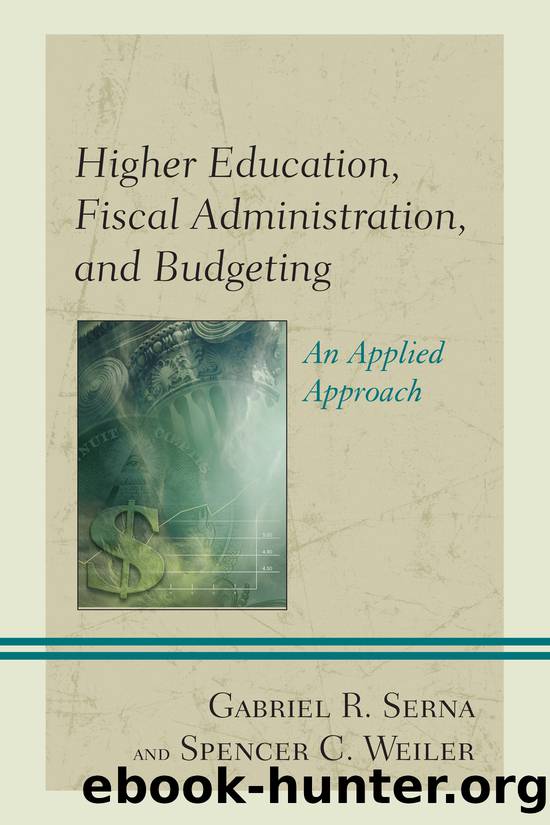Higher Education, Fiscal Administration, and Budgeting by Serna Gabriel R.;Weiler Spencer C.; & Spencer C. Weiler

Author:Serna, Gabriel R.;Weiler, Spencer C.; & Spencer C. Weiler
Language: eng
Format: epub
Publisher: Rowman & Littlefield Publishers, Incorporated
RESPONDING DURING THE BUDGET PROCESS
There are obviously varied responses to changes that occur during the budget process and cycle. However, before responding leaders overseeing budgets should have clearly defined answers to the following questions prior to having to increase or decrease a budget:
1.What principles guide your decision-making process when developing a budget?
2.What would you not change in a departmental, office, or institutional budget under any circumstance? Why?
3.What would you be willing to add to or cut from a budget? Why?
Because budget philosophy is central to the resource allocation process, an explicit statement or understanding of the principles undergirding decision-making will help make the budget allocation process much easier. This means that before the budget process gets under way, the budget manager should consider which principles will guide decision-making. In higher education this task is not a simple one.
For example, multiple criteria could be used to make a fiscal decision such as: do we wish our decisions to result in equal, equitable, efficient, or some other result? Do we wish for some combination of these? If so, which principles are most important, and how do we compare alternatives? These are just a few questions that might arise as the budget manager makes decisions or compares budgetary outcomes.
The next discussion point should center on the institutionâs vision statement, mission statement, and goals. In other words, based on the goals of the institution, what are some things that we are unwilling to change or give up? As the budget is the physical representation of the institutionâs objectives, knowing the answers, or at least considering them, will certainly help make for a smoother budget process.
In lean times, across the board cuts might be considered as part of the process or in times of plenty across the board increases. What arises then is a concern with whether the mission and values of the institution are truly reflected in the budget process and the resulting document. That is to say, clear articulation of why certain resource allocation decisions make sense based on the goals and objectives of the college or university can significantly lighten the workload related to fiscal administration.
One sage piece of advice offered by budget and planning scholars (Barr & McClellan, 2011; Goldstein, 2012) is that regardless of the choices to be made, the human costs and impacts on employee and institutional morale that these decisions engender should always be considered.
Finally, the third point is deciding what the institution is willing to change. While the second and third points may seem redundant, the truth is that providing information on both budgetary decisions that will not change and those that will can provide room for compromise. For example, assume that the core mission of an institution is engineering education. Then perhaps there is a strong interest in maintaining funding to engineering and math programs.
In the same institution, assume that new cost-savings have arisen and that faculty wages have remained frozen for a few years. While the institution might be unwilling to consider cuts to the
Download
This site does not store any files on its server. We only index and link to content provided by other sites. Please contact the content providers to delete copyright contents if any and email us, we'll remove relevant links or contents immediately.
| Administration | Adult & Continuing Education |
| Business School Guides | College Guides |
| Financial Aid | Graduate School Guides |
| Law School Guides | Medical School Guides |
| Test Preparation | Vocational |
Navigation and Map Reading by K Andrew(4558)
Spare by Prince Harry The Duke of Sussex(4221)
Tuesdays with Morrie by Mitch Albom(3839)
Cracking the GRE Premium Edition with 6 Practice Tests, 2015 (Graduate School Test Preparation) by Princeton Review(3600)
What It Really Takes to Get Into Ivy League and Other Highly Selective Colleges by Hughes Chuck(3224)
Goodbye Paradise(2976)
Never by Ken Follett(2905)
Pledged by Alexandra Robbins(2796)
Kick Ass in College: Highest Rated "How to Study in College" Book | 77 Ninja Study Skills Tips and Career Strategies | Motivational for College Students: A Guerrilla Guide to College Success by Fox Gunnar(2724)
A Dictionary of Sociology by Unknown(2521)
Graduate Admissions Essays, Fourth Edition: Write Your Way into the Graduate School of Your Choice (Graduate Admissions Essays: Write Your Way Into the) by Asher Donald(2479)
Sapiens and Homo Deus by Yuval Noah Harari(2420)
Get into Any College by Tanabe Gen Tanabe Kelly(2387)
Zero to Make by David Lang(2349)
Machine Learning at Scale with H2O by Gregory Keys | David Whiting(2316)
The Social Psychology of Inequality by Unknown(2315)
500 Must-Know AP Microeconomics/Macroeconomics Questions(2245)
Fairy Tale by Stephen King(2090)
Will by Will Smith(2060)
